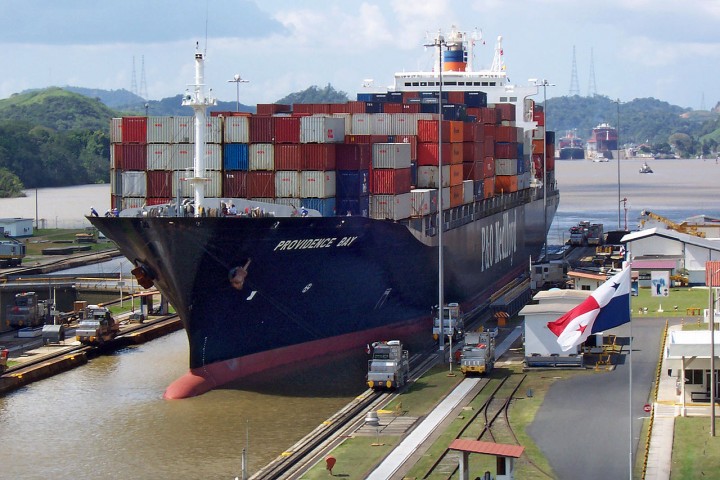By the time it officially opened on August 15, 1914, over 5,000 workers–mostly Barbadians–had died building the Panama Canal. And that’s only according to hospital records; countless people were crushed by landslides and machinery at the Culebra Cut, or spent their last moments choking on the dreaded vómito negro at home. Plus this death toll only accounts for those who died during the American construction period between 1904 and 1914. Two decades earlier, the French had spent at least 20,000 lives–mostly Jamaican–in a madcap campaign to build their grande tranchée across the isthmus.
Disparate death tolls and sources of labor aren’t the only thing separating the French effort from the American one. Whereas Ferdinand de Lesseps–“Le Grand Français” who built the Suez Canal–wanted to duplicate his earlier feat on a much larger scale by carving out a sea-level waterway through the Panamanian jungle, the self-styled grand américain Teddy Roosevelt decided on a lock canal that would form a virtual bridge of water over the land. Whereas the French put their project in the hands of a corporation, the American government funded and administered the digging itself, even putting an Army colonel in charge to “make the dirt fly.” Whereas the French never learned what caused the yellow fever and malaria which decimated their workforce, the Americans implemented new theories and methods to eradicate the mosquitos that spread such diseases. And whereas the French attempt and eventual failure signaled the decline of Europe’s power and prestige, the United States’ tour de force heralded the launch of an American century.
The entire drama is rendered vividly in Matthew Parker’s Panama Fever, a book I had wanted to read ever since ever since I closed The Sugar Barons, also by Parker. As well as being a superb scholar, the Central American-born British historian is also a topnotch storyteller, and although I would read a book on Latin American history if it made my eyes turn into raisins, reading history that is beautifully written is like having a chef pack your lunchbox.
Most of the time, choosing one history to read from the pile of others feels almost arbitrary. Learning about the Panama Canal requires no more urgency than learning what Nicaragua was like under the Somoza dictatorship. As an ardent student of history, I often feel as though I’m being strung along haphazardly from book to book. But then there are those moments when it seems I was meant to read a particular book at a particular time, as when President Obama announced the rapprochement with Cuba just as I had devoured the last bits of Fidel’s 2006 autobiography.
So it was with my reading of Panama Fever, which coincided with reports from the isthmus about a drought, the near completion of a canal extension project and its subsequent labor strikes.
After having read Parker’s history of the canal, I can’t help noting the irony in a drought decreasing the traffic through a waterway whose construction was constantly frustrated by torrents of rain. Both the French and the Americans faced three mortal foes in Panama: the Culebra mountain ridge, Aedes aegypti and the Río Chagres. The French project was foiled almost single-handedly by what one of the French engineers called “the implacable enemy of our great enterprise”–the Chagres. Only when the Americans built the dam at Gatum would construction on the canal be safe from destructive floods.
Now Panama is facing the driest summer in its recorded history. The drop in water level has forced the Panama Canal Authority to lower the maximum draft of passing ships by half an inch, and officials say they may lower it by another half-inch if the isthmus doesn’t get enough rain soon.
On Wednesday the conglomerate working on the canal extension project came to an agreement with the canal workers’ union, avoiding a strike that could have delayed the April 2016 opening. Able to accommodate New Panamax ships–those larger than the old locks but small enough for the new ones–the expansion project is expected to carry 510 million tons by 2025, doubling the tonnage that passed through the canal in 2005.

Still, Panama’s century-long standing as the passageway through the Americas may fade into history if the Hong Kong billionaire Wang Jing actually finishes his canal through neighboring Nicaragua, which he promises will be able to handle the growing number of post-Panamax ships that are even too big for the Panama’s extended locks. That the Chinese have begun carving a canal through Central America nearly four times the length of the one in Panama no doubt has some Westerners worried–none more than the United States, which has been fighting a thinly-veiled economic war with the “Red Giant” for at least the past 20 years.
In another ironic twist, it was the Americans who seriously considered building a canal through Nicaragua as early as 1825. Support for the proposed waterway intensified once the French announced their designs for Panama, and the possibility of acquiring the Panama canal project from the French 20 years later led to the “Battle of the Routes” in Congress.
What reading Panama Fever illuminated most of all is the reality that–like the canal itself–the concept of Latin America should really be broadened to include the former subjects of neither an Iberian crown or even a French one. A large majority of the canal workforce were blacks from the British West Indies, namely Jamaica and Barbados. The men who worked the canal–especially during the American period–were key actors in one of the defining moments of Latin American history, when the United States began to exert its political, economic and military might on the region.
Just as Panama sits at the nexus of Latin America, so too does the “Panama Man” stand at the center of what it means to be an American–in the way the term was used by Bolívar and Martí, not how it’s used by the estadounidenses.
[Image: Public Domain]